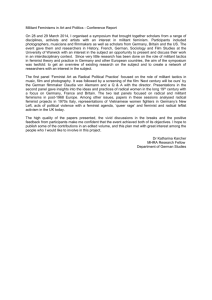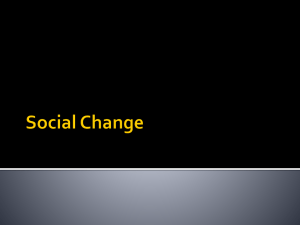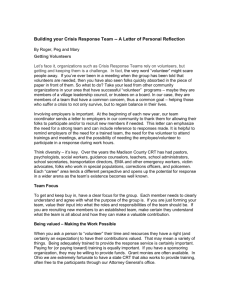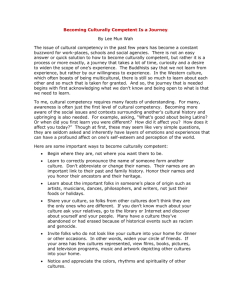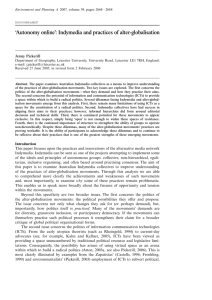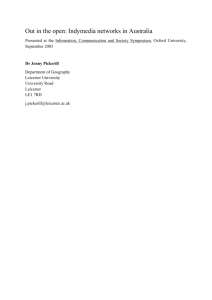The Trajectory Of Change
advertisement
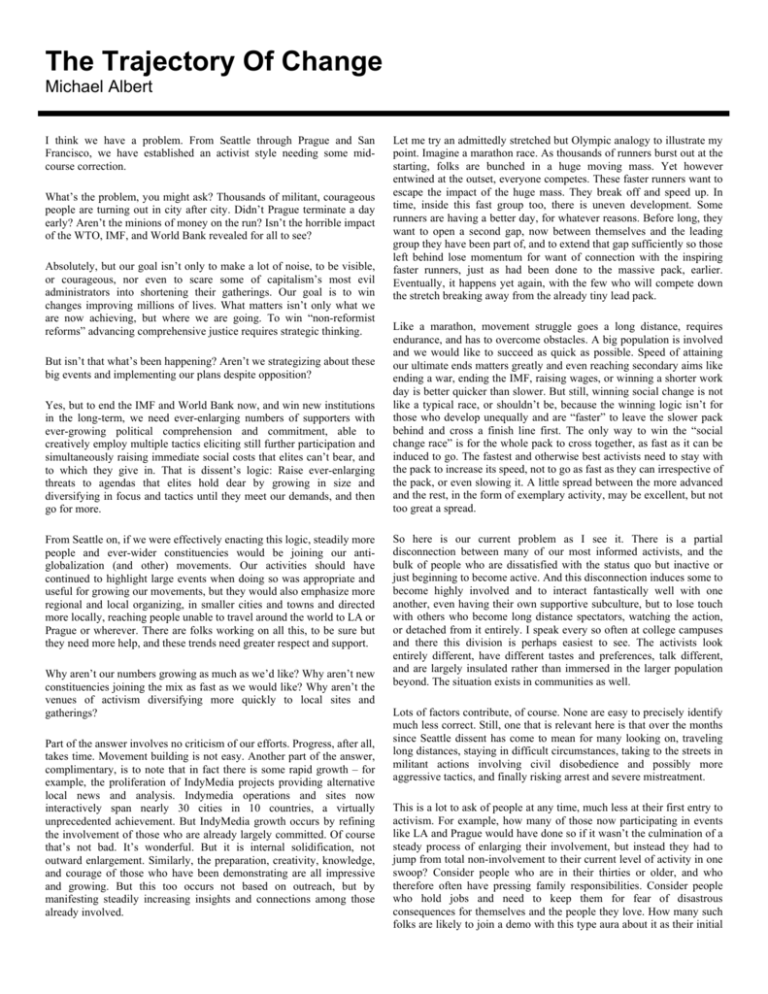
The Trajectory Of Change Michael Albert I think we have a problem. From Seattle through Prague and San Francisco, we have established an activist style needing some midcourse correction. What’s the problem, you might ask? Thousands of militant, courageous people are turning out in city after city. Didn’t Prague terminate a day early? Aren’t the minions of money on the run? Isn’t the horrible impact of the WTO, IMF, and World Bank revealed for all to see? Absolutely, but our goal isn’t only to make a lot of noise, to be visible, or courageous, nor even to scare some of capitalism’s most evil administrators into shortening their gatherings. Our goal is to win changes improving millions of lives. What matters isn’t only what we are now achieving, but where we are going. To win “non-reformist reforms” advancing comprehensive justice requires strategic thinking. But isn’t that what’s been happening? Aren’t we strategizing about these big events and implementing our plans despite opposition? Yes, but to end the IMF and World Bank now, and win new institutions in the long-term, we need ever-enlarging numbers of supporters with ever-growing political comprehension and commitment, able to creatively employ multiple tactics eliciting still further participation and simultaneously raising immediate social costs that elites can’t bear, and to which they give in. That is dissent’s logic: Raise ever-enlarging threats to agendas that elites hold dear by growing in size and diversifying in focus and tactics until they meet our demands, and then go for more. From Seattle on, if we were effectively enacting this logic, steadily more people and ever-wider constituencies would be joining our antiglobalization (and other) movements. Our activities should have continued to highlight large events when doing so was appropriate and useful for growing our movements, but they would also emphasize more regional and local organizing, in smaller cities and towns and directed more locally, reaching people unable to travel around the world to LA or Prague or wherever. There are folks working on all this, to be sure but they need more help, and these trends need greater respect and support. Why aren’t our numbers growing as much as we’d like? Why aren’t new constituencies joining the mix as fast as we would like? Why aren’t the venues of activism diversifying more quickly to local sites and gatherings? Part of the answer involves no criticism of our efforts. Progress, after all, takes time. Movement building is not easy. Another part of the answer, complimentary, is to note that in fact there is some rapid growth – for example, the proliferation of IndyMedia projects providing alternative local news and analysis. Indymedia operations and sites now interactively span nearly 30 cities in 10 countries, a virtually unprecedented achievement. But IndyMedia growth occurs by refining the involvement of those who are already largely committed. Of course that’s not bad. It’s wonderful. But it is internal solidification, not outward enlargement. Similarly, the preparation, creativity, knowledge, and courage of those who have been demonstrating are all impressive and growing. But this too occurs not based on outreach, but by manifesting steadily increasing insights and connections among those already involved. Let me try an admittedly stretched but Olympic analogy to illustrate my point. Imagine a marathon race. As thousands of runners burst out at the starting, folks are bunched in a huge moving mass. Yet however entwined at the outset, everyone competes. These faster runners want to escape the impact of the huge mass. They break off and speed up. In time, inside this fast group too, there is uneven development. Some runners are having a better day, for whatever reasons. Before long, they want to open a second gap, now between themselves and the leading group they have been part of, and to extend that gap sufficiently so those left behind lose momentum for want of connection with the inspiring faster runners, just as had been done to the massive pack, earlier. Eventually, it happens yet again, with the few who will compete down the stretch breaking away from the already tiny lead pack. Like a marathon, movement struggle goes a long distance, requires endurance, and has to overcome obstacles. A big population is involved and we would like to succeed as quick as possible. Speed of attaining our ultimate ends matters greatly and even reaching secondary aims like ending a war, ending the IMF, raising wages, or winning a shorter work day is better quicker than slower. But still, winning social change is not like a typical race, or shouldn’t be, because the winning logic isn’t for those who develop unequally and are “faster” to leave the slower pack behind and cross a finish line first. The only way to win the “social change race” is for the whole pack to cross together, as fast as it can be induced to go. The fastest and otherwise best activists need to stay with the pack to increase its speed, not to go as fast as they can irrespective of the pack, or even slowing it. A little spread between the more advanced and the rest, in the form of exemplary activity, may be excellent, but not too great a spread. So here is our current problem as I see it. There is a partial disconnection between many of our most informed activists, and the bulk of people who are dissatisfied with the status quo but inactive or just beginning to become active. And this disconnection induces some to become highly involved and to interact fantastically well with one another, even having their own supportive subculture, but to lose touch with others who become long distance spectators, watching the action, or detached from it entirely. I speak every so often at college campuses and there this division is perhaps easiest to see. The activists look entirely different, have different tastes and preferences, talk different, and are largely insulated rather than immersed in the larger population beyond. The situation exists in communities as well. Lots of factors contribute, of course. None are easy to precisely identify much less correct. Still, one that is relevant here is that over the months since Seattle dissent has come to mean for many looking on, traveling long distances, staying in difficult circumstances, taking to the streets in militant actions involving civil disobedience and possibly more aggressive tactics, and finally risking arrest and severe mistreatment. This is a lot to ask of people at any time, much less at their first entry to activism. For example, how many of those now participating in events like LA and Prague would have done so if it wasn’t the culmination of a steady process of enlarging their involvement, but instead they had to jump from total non-involvement to their current level of activity in one swoop? Consider people who are in their thirties or older, and who therefore often have pressing family responsibilities. Consider people who hold jobs and need to keep them for fear of disastrous consequences for themselves and the people they love. How many such folks are likely to join a demo with this type aura about it as their initial steps in becoming active – a demo seeming to demand great mobility and involving high risks? The irony in all this is that the efficacy of civil disobedience and other militant tactics is not something cosmic or a priori. It resides, instead, in the connection between such militant practices and a growing movement of dissidents, many not in position to join such tactics, but certainly supportive of their logic and moving in that direction. What gives civil disobedience and other militant manifestations the power to force elites to submit to our demands is the fear that such events forebode a threatening firestorm. But if there is a 2,000 or even a 10,000 person sitin, even repeatedly, but with no larger, visible, supporting dissident community from which the ranks of those sitting-in will be replenished and even grow, then there is no serious threat of a firestorm. In other words, dissent that appears to have reached a plateau, regardless of how high that plateau is, has no forward trajectory and is therefore manageable. Plateau-ed dissent is an annoyance that the state can control with clean-up crews or repression. In contrast, growing dissent that displays a capacity to keep growing, even when much smaller, is more threatening and thus more powerful. Civil disobedience involving a few thousand people, with ten or twenty times as many at associated massive rallies and marches all going back to organize local events that are still larger, gives elites a very dangerous situation to address. Through personal encounters, print, audio, and video messaging, teach-ins, rallies, and marches, folks are moving from lack of knowledge to more knowledge and from rejecting demonstrating to supporting and when circumstances permit joining it. A huge and growing mass of dissident humanity restricts government options for dealing with the most militant disobedience. This is not a plateau of dissent for elites to easily manage or repress, but a trajectory of forwardmoving growth that elites must worry about. It follows, however, that if the state can create an image in which the only people who should come out to demonstrate are those who are already eager or at least prepared to deal with gas, clubs, and “extended vacations,” then at the demos we are not going to find parents with their young babies in strollers, elderly folks whose eyes and bones couldn’t take running through gas, young adults kept away from danger by their parents concerned for their well being, or average working people of all kinds unable to risk an unpredictable time away from work. Add to this mix insufficient means to manifest one’s concerns and develop one’s views and allegiance locally, and the movement is pushed into a plateau condition. The problem we have, therefore, is an operational disconnect between the movement and certain types of organizing, and therefore between the movement and the uninvolved but potentially receptive public. I know this assessment, even moderated by recognition of all that has been accomplished and recognizing that there are even energies directed at these very problems, will sound harsh to many folks, but even with the many exemplary exceptions, it is important to acknowledge that these matters need more attention. Consider but one example. The internet is a powerful tool, useful in many ways to our work. But with the internet, mostly we are communicating with folks who want to hear what we have to say. They come to our sites and participate in our lists because they are already part of the movement. How else would they know where to find us? This is similar to what occurs with a print periodical or radio show that we might have in our arsenal of left institutions. Only those who subscribe or to listen almost always because they already know that they want to hear what we have to say, hear our message. Don’t get me wrong. This is good, for sure—and I have spent a lot of my life working on such efforts which I feel are part and parcel of advancing our own awareness, insights, solidarity, and commitment, and of refining our methods and agendas, tooling and retooling ourselves for the tasks at hand. The trouble is, returning to the earlier analogy, if done without prioritizing other more face to face and public activity, it can lead to us becoming a breakaway, intentionally or not, and thereby largely leaving behind the constituencies we need to communicate with. Another different kind of organizing is explicit outreach, aimed not at solidifying and intensifying the knowledge and commitment of those who already speak our language and share our agendas, but at reaching people who differ with us. This is what is going on when we hand out leaflets or do agitprop and guerilla theatre in public places. It is what happens when we hold public rallies or teach-ins and we don’t only email those eager to come, but, in addition and as our main priority, we go door to door in our neighborhoods or on our campuses, urging, cajoling, inducing, and even pressuring folks to come to the events. This face-to-face interaction with people who aren’t agreeing with us already, or who even disagree strongly with us, is at the heart of movement building. It is harder and scarier than communicating with those who share our views, of course, but it is even more important to do. To the extent outreach is going to touch, entice, and retain new people in our movements, it has to offer them ways to maintain contact and thereby sustain and grow their initial interest. If the end point of a faceto-face conversation about the IMF, for example, is that we urge someone to travel 500 or 1000 or 5000 miles to a demonstration, sleep on a floor or not sleep at all, and take to the streets in a setting where, whether it is warranted or not, they expect to be gassed and face arrest and extended detention keeping them away from kids and jobs, few if any newcomers are going to jump in. But, absent continuing involvement, with nothing obvious and meaningful to do, there is no way to retain contact to the committed activist community that has piqued their dissident interest. As a result, their anger will most likely dissipate in the fog imposed by daily life and mainstream media. Thus, without mechanisms to preserve and enforce its initial impact, outreach to new folks won’t take hold. We plan the next demo, go to it, and celebrate with the same crowd as at the last demo. I think this picture, with many variations, broadly describes a major problem that prevents our efforts--as fantastically impressive as they have been—from being not just impressive, but overwhelmingly powerful and victorious. So I think more attention has to go to expanding and refining our agendas, not to eliminate our more militant tactics – not at all – but to give them greater meaning and strength by incorporating much more outreach, many more events and activities that have more diverse and introductory levels of participation, and also more local means for on-going involvement by people just getting interested, all still tied, of course, to the over-arching national and global movements for change. The Trajectory Of Change 2003 (re-)Printed by the Akron Anti-Authoritarian Reading Group (AAARG!)
